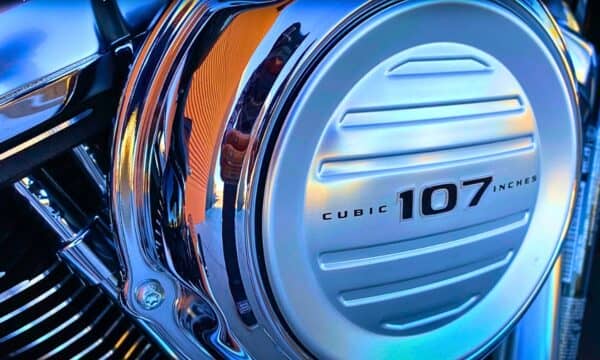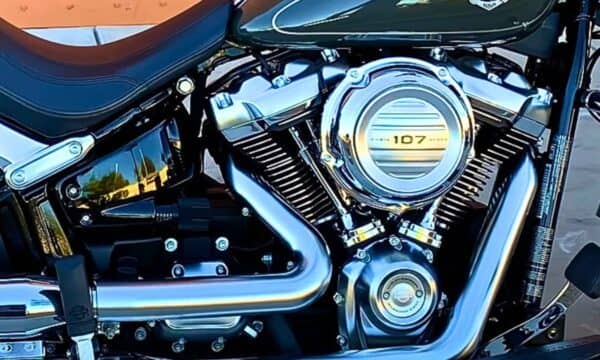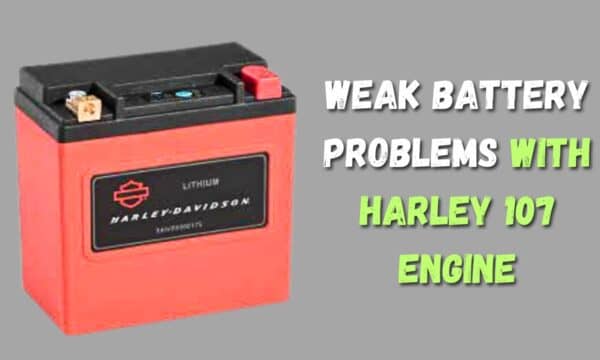If you are wondering about the common problems of Harley 107, don’t worry because you are not alone.

Many users need to be made aware of the problems of Harley 107 and need help fixing these issues.
We have worked to find all the possible problems with Harley 107 and found the solutions to these problems.
Let’s dive into:
Common Milwaukee Eight 107 Problems
Like any other engine, the Harley Davidson 107 has a few drawbacks that may affect a motorcycle’s performance.
Some users experience oil consumption, heat management failure, and transmission issues with Harley 107.
1. Oil Consumption
Over time, piston rings can damaged or become faulty, which causes increased oil consumption in Harley Davidson 107.
So, first, you should remove the pistons and replace the piston rings. It is less common than you think because you will need different tools to access the piston rings and check them for damage or fault.
Sometimes, the valve guide seals are damaged for many reasons, which allows oil to leak into the combustion chamber.
Check the valve guide seals and make sure they are not leaking or damaged at any point. You may need to remove the cylinder head to replace the valve guide seals.

It is also a complex task; if you need to learn the connections better, hire a Harley-certified technician.
Many users faced external leaks with Harley 107 caused by failing gaskets, seals, or cracked components. Identify and fix any external oil leaks.
Replace faulty gaskets, seals, or damaged components. You might need to disassemble engine parts for some leaks, so ensure you’re comfortable with this level of repair.
If the PCV (Positive Crankcase Ventilation) system malfunctions, it might not effectively manage engine pressures and oil flow.
Check the PCV valve and related components for damage or clogs and replace them if needed. Ensure the system is working correctly to maintain proper oil circulation and consumption.
Related: Is Harley Davidson 103 Engine Good?
2. Heat Management
The Harley-Davidson Milwaukee-Eight 107 engine sometimes encounters heat management problems. Heat issues can be uncomfortable for riders and damage the engine over time.
Some users experience overheating, which can occur during prolonged idling, slow riding, or riding in hot climates.
Riders often experience discomfort due to the heat radiating from the engine, particularly in the thigh area.
You can improve the heat management systems by trying a few things. Firstly, use a high-performance air cleaner or improve the intake system for airflow to the engine, which helps the engine to breathe better and run cooler.
You could also go with the aftermarket oil coolers and cooling fans, significantly reducing engine temperatures. Some riders opt for aftermarket oil coolers or upgraded fans to improve cooling efficiency.
Aftermarket exhaust systems can also reduce heat generation. When you select an exhaust, look for one designed to minimize heat, and consider ceramic-coated options that reflect heat away from the rider and the engine.
A proper tune can improve the overall efficiency and performance of the engine, leading to cooler running temperatures. It can be achieved through an ECU remap or aftermarket tuning devices.
3. Transmission Issues
Sometimes, you will have trouble shifting, which could be due to a misadjusted clutch, worn clutch components, or issues with the shift mechanism itself.
You should adjust or replace the clutch or address the specific shifting component problem to resolve these issues.
Many users observe noise from the transmission, especially in neutral, which can sometimes indicate worn bearings or gear teeth.
You should check the specific components; if these parts require repair, then you should repair them; if they require a replacement, replace them with the newer parts.
If the transmission slips out of gear while riding, it could be due to worn gear teeth, a bent shift fork, or other internal damage.
It might require opening up the transmission for repair or replacement of the damaged components.
Related: Milwaukee 107 vs 103
4. Weak Battery
Weak battery issues with Harley-Davidson motorcycles equipped with the Milwaukee-Eight 107 engine can stem from various causes.
Batteries have a limited lifespan, usually between 2 to 5 years for lead-acid batteries. Aging batteries tend to lose their charge quickly.

If the motorcycle is not ridden regularly, the battery can discharge over time, which may result in starting issues.
The motorcycle’s charging system might not function properly, which leads to an undercharged or overcharged battery.
Something is drawing power from the battery even when the motorcycle is off. It could be an accessory, alarm system, or a short in the electrical system.
Battery performance could be affected by both weather conditions, often leading to weakened or dead batteries in extreme conditions.
How to Fix Weak Battery Problems
Replace the Battery: If the battery is old, replacing it with a new one is often the simplest solution.
Maintain Charge: A trickle charger keeps the battery charged when the motorcycle isn’t used for extended periods.
Check Charging System: Have the charging system inspected and repaired if necessary. It includes checking the alternator, voltage regulator, and any related wiring.
Identify and Eliminate Parasitic Drains: Investigate and repair any electrical issues causing power drains.
Protect Battery from Extreme Temperatures: Store the motorcycle in a climate-controlled environment or insulate the battery from extreme temperatures.
5. Starter Problems
Sometimes, it takes work to start the Harley 107, and many users experience the same problems on different forums. There could be several reasons you struggle to start your Harley 107.
A dead battery is a cause of starting problems. Ensure the battery is fully charged. If it’s old or damaged, consider replacing it. Regular maintenance, including cleaning the terminals, can also prevent issues.
The stator motor can become faulty over time. If you observe a clicking noise, the starter motor might be the culprit, but the engine doesn’t turn over. A replacement stator motor is needed to fix the problem.
The ignition switch can fail, leading to a no-start condition. Check the switch, and if it is faulty, you must replace it.
Problems in the fuel system, like a clogged fuel filter or malfunctioning fuel pump, can prevent the engine from starting. Regular maintenance and replacement of faulty components can remedy these issues.
Worn or fouled spark plugs can prevent the engine from starting. Inspect the plugs and replace them if necessary.
Modern engines rely on various sensors to operate efficiently. A faulty sensor, like a crankshaft or camshaft position sensor, can prevent starting. Diagnosis and replacement of defective sensors are often required.
6. Valve Train Noise
Reasons
The valve train components can be damaged over time, leading to increased clearance and noise. Sometimes, during repair work, the valves lash adjusted incorrectly, which can cause tapping or ticking noises.
If the oil supply is inadequate to the valve train, it may cause increased friction and noise. The damaged or defective parts within the valve train are leading to abnormal sounds.
Solutions
You should conduct routine maintenance and inspections to identify and address damages early. Follow the manufacturer’s maintenance schedule and guidelines for your specific model.
To fix the lash adjustment issues, you should check and adjust the valve lash according to the specifications provided in the service manual. It helps to ensure the proper clearance between the valve train components.
Always use the correct engine oil grade and type as Harley-Davidson recommends. Regularly check and maintain the oil level to ensure adequate lubrication.
If any valve train parts are damaged or worn out, replace them with genuine Harley-Davidson or approved aftermarket components.
7. Throttle Response
The throttle response problems in the Harley 107 (Milwaukee-Eight 107) engine can be attributed to various factors. While this list may not be exhaustive, here are some common reasons and potential solutions.
Electronic Throttle Control (ETC) Issues
The ETC, known as the “fly-by-wire” system, can develop glitches or malfunctions, leading to delayed or inconsistent throttle response.
You should regularly inspect the throttle body and its wiring. Ensure that the throttle body is clean and there are no loose or damaged wires.
Dirty/Clogged Air Filter
Dirt in the air filter can restrict airflow into the engine, affecting the air-fuel mixture and throttle response.
Check and clean the air filter. Replace it if it’s too clogged or worn out.
Issues with the Fuel System
Contaminated fuel, a clogged fuel filter, or problems with the fuel injectors can lead to poor throttle response. Use high-quality fuel, and regularly check the fuel filter and fuel injectors.
Exhaust System Restrictions
The clogged or restricted exhaust system can hinder the engine’s performance and throttle response. Inspect the exhaust system for any obstructions or damage. Consider upgrading to a performance exhaust system if needed.
ECU (Engine Control Unit) Mapping
The stock ECU mapping might only be optimized for some riding conditions, leading to sub-optimal throttle response.
Consider getting a custom ECU tune or using aftermarket tuning modules to optimize the air-fuel ratio and improve throttle response.
Throttle Grip Issues
Damage to the throttle grip can cause it to stick or not return properly. Check the throttle grip and cables. Lubricate or replace them if they show signs of wear or damage.
Conclusion
Many users of Harley 107 reported excessive oil consumption problems with the engine, which could be due to several reasons.
You may also face heat management system failure, which could be frustrating for long rides, but you can fix these issues by using aftermarket parts.
Sometimes, battery issues also impact the performance of Harley 107, and you would also need help to start your motorcycle.
FAQs
Did Harley discontinue the 107 engine?
Yes, Harley Davidson has discontinued the 107 engine in favour of the larger, more powerful 114 engine for its 2020 lineup.
This change is part of Harley’s broader revamp to appeal to a new generation of riders, offering them more power, performance, and speed.
Is the Harley 107 liquid cooled?
No, the Harley Davidson 107 engine, also known as the Milwaukee-Eight 107, is not liquid-cooled. It utilizes air-cooling technology, a common feature in traditional Harley-Davidson motorcycles.
However, it’s worth noting that the Harley Davidson Milwaukee-Eight series also includes a 114 and 117 engine, which offer liquid-cooling options in certain models.
How many cc is a HD 107 engine?
The HD 107 engine, which stands for Harley Davidson 107, is 1745 cubic centimetres (cc).
It is one of the most powerful ones offered by Harley Davidson, providing riders with a thrilling experience.
You can also check out the Harley 88 engine, 96 engine, 103 engine, 110 engine, 114 engine, 117 engine, 120R engine, 131 engine and Evolution engine Problems.

Ahtsham Younas is a passionate blogger and content writer. He loves to ride motorcycles and learn the mechanical process behind the motorcycles.
He has been writing articles in the motorcycle industry since 2019 and has learned many things about motorbike niches.


